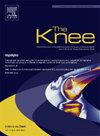Evaluation of anterior intermeniscal ligament in types of bucket-handle tear with using magnetic resonance ımaging
IF 2
4区 医学
Q3 ORTHOPEDICS
引用次数: 0
Abstract
Background
Anterior intermeniscal ligament (AIML) has a beneficial influence on knee biomechanics, contributing to shock-absorbing function of the menisci and to the transmission of circumferential hoop stresses in the knee. Investigation of the relationship between meniscal bucket-handle tears and the AIML may help to elucidate AIML function. The aim of this study was to determine AIML according to anatomical insertions in groups composed of central and peripheral type bucket-handle tear cases.
Methods
In total 104 cases with bucket-handle tear were re-evaluated with magnetic reonance imaging (MRI) for AIML and tear pattern. AIMLs were grouped according to the classification of Nelson and LaPrade. Two groups of bucket-handle tear cases were recorded according to the tear pattern as central or peripheral according to the Cooper classification. Chi-squared analysis and Fisher’s exact test were used for correlation and significance analysis between AIML subtypes and the two types of bucket-handle tear.
Results
No significant correlation was found between the AIML and the groups consisting of different patterns of bucket-handle tear (P = 0.063). Peripheral zone tears were found in 53 (51%) patients, whereas central zone tears were found in 51 (49%) patients. AIML was absent in 51 patients. Type I AIML was present in 21, type II in 24, and type III in eight patients.
Conclusions
The distribution of AIML in different patterns of bucket-handle tear cases was not statistically significant and did not differ from the normal ratios specified in the literature.
前半月板间韧带在桶柄型撕裂中的磁共振评价ımaging
前半月板间韧带(AIML)对膝关节生物力学有有益的影响,有助于半月板的减震功能和膝关节内环向应力的传递。探讨半月板桶柄撕裂与AIML的关系有助于阐明AIML的功能。本研究的目的是根据中心型和外周型桶柄撕裂病例组成的组的解剖插入来确定AIML。方法对104例桶柄撕裂患者进行磁共振成像(MRI)检查AIML及撕裂形态。根据Nelson和LaPrade的分类对AIMLs进行分组。将桶柄撕裂分为中心型和外周型两组,按照Cooper分类进行记录。采用卡方分析和Fisher精确检验对AIML亚型与两种桶柄撕裂的相关性和显著性进行分析。结果AIML与不同类型桶柄撕裂组无显著相关性(P = 0.063)。53例(51%)患者发现外周带撕裂,51例(49%)患者发现中心带撕裂。51例患者无AIML。21例为I型,24例为II型,8例为III型。结论AIML在不同类型的桶柄撕裂病例中的分布无统计学意义,与文献中规定的正常比例无显著差异。
本文章由计算机程序翻译,如有差异,请以英文原文为准。
求助全文
约1分钟内获得全文
求助全文
来源期刊

Knee
医学-外科
CiteScore
3.80
自引率
5.30%
发文量
171
审稿时长
6 months
期刊介绍:
The Knee is an international journal publishing studies on the clinical treatment and fundamental biomechanical characteristics of this joint. The aim of the journal is to provide a vehicle relevant to surgeons, biomedical engineers, imaging specialists, materials scientists, rehabilitation personnel and all those with an interest in the knee.
The topics covered include, but are not limited to:
• Anatomy, physiology, morphology and biochemistry;
• Biomechanical studies;
• Advances in the development of prosthetic, orthotic and augmentation devices;
• Imaging and diagnostic techniques;
• Pathology;
• Trauma;
• Surgery;
• Rehabilitation.
 求助内容:
求助内容: 应助结果提醒方式:
应助结果提醒方式:


